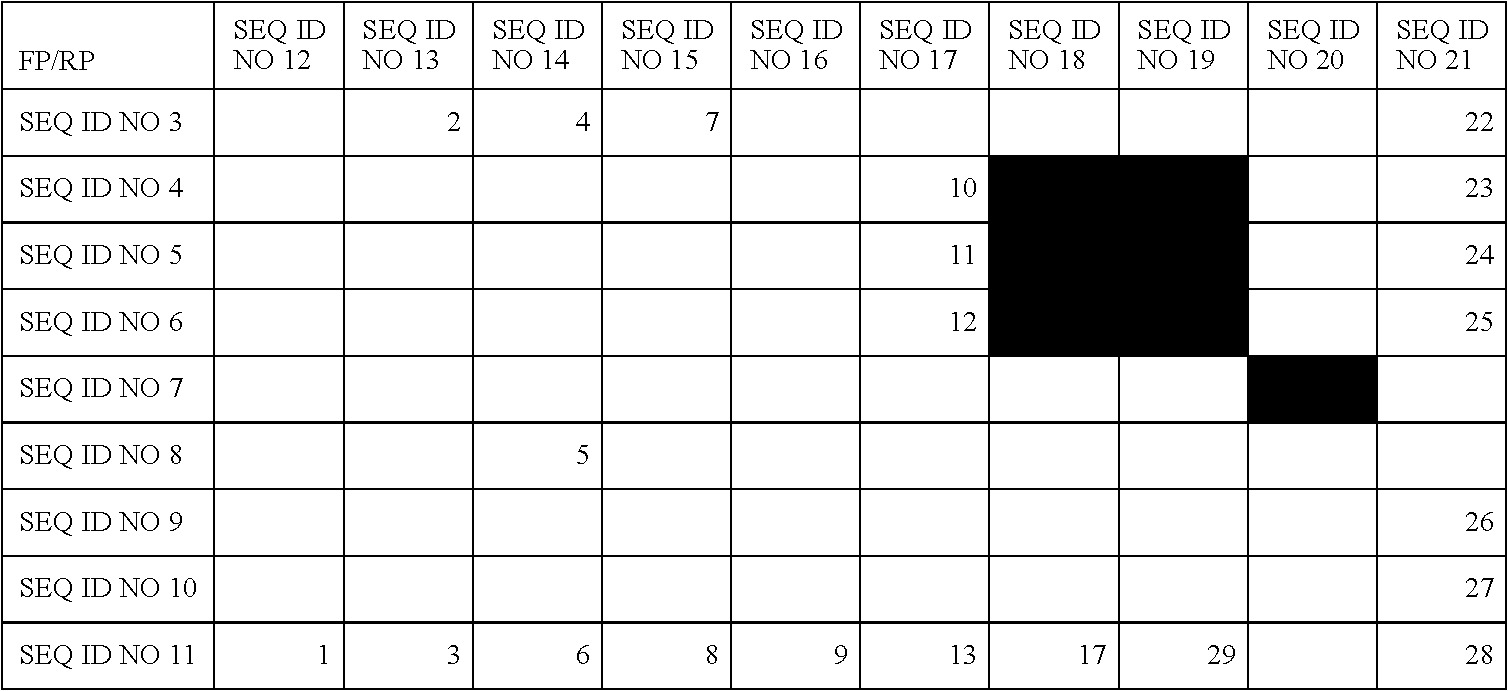Detection, identification and differentiation of eubacterial taxa using a hybridization assay
a technology of eubacterial taxa and hybridization assay, which is applied in the field of detection, identification and differentiation of eubacterial taxa using a hybridization assay, can solve the problems that several recently described species do not conform to the phenotypic characteristics, and achieve rapid and reliable hybridization
- Summary
- Abstract
- Description
- Claims
- Application Information
AI Technical Summary
Benefits of technology
Problems solved by technology
Method used
Image
Examples
example 1
Preparation of the Samples to be Tested
[0198]1 / . DNA from Pure Cultures
[0199]For extracting the DNA from pure cultures, different purification methods can be used:[0200]Lysis with lysostaphin (5 μg / μl) for 1 h at 37° C. and purification with the QIAamp blood DNA isolation kit (Qiagen)[0201]The method of Pitcher et al. (1989)[0202]The MagNAPure LC DNA isolation Kit III (Bacteria, Fungi) on the MagNAPure instrument. Bacterial cells grown O / N on LB plates or slants were suspended in 100 to 1000 μl TE pH8 for storage at −20° C. 2 μl to 20 μl was used for extraction according to the manufacturer's recommendations.[0203]QIAamp DNA mini kit (catalog no. 51306-QIAGEN). The culture was pre-treated enzymatically using lysozyme and lysostaphin.
[0204]2 / . DNA from Positive Blood Culture Bottles
[0205]Blood samples were inoculated in aerobe blood culture bottles (BacT / ALERT FA) and incubated in a BacT / Alert 3D system (Organon Teknika) at 37° C. until positive. Positivity was monitored by a color c...
example 2
LightCycler (LC) Protocol
[0208]Following the instructions of the manufacturer of the kit LC-FastStart DNA Master Hybridization Probes (cat. No 3 003 248 or No 2 239 272):[0209]any sample material suitable for PCR in terms of purity, concentration, and absence of inhibitors can be used;[0210]the primers should be at a final concentration of 0.3 to 1 μM each;[0211]the HybProbes at a final concentration of 0.2 μM each, or double;[0212]the concentration of MgCl2 should be optimized, and may vary from 1 to 5 mM;[0213]and a negative control should be run.
[0214]The amplification and melting conditions are described herein after. The LC software version 3.5 was used. The quantification settings were F2 / back F1 (samples). For the baseline adjustment the arithmetic mode was used. The crossing point (Ct) calculation was based on the second derivative maximum. The calculation method for the melting peak was polynomial. The peak area was used to calculate the Tm.
[0215]Amplification and melting c...
example 3
Results on Purified DNA, Inclusively and Cross Reactivity Tests
[0216]1 / Inclusivity
[0217]In total 47 isolates received as E. faecalis were examined. All produced quantification curves (Ct range 15.5-28.4) and 44 had melting peaks around 58° C. (Tm range 57.4° C.-58.3° C., mean Tm=57.9° C.).
[0218]Three out of the 47 isolates received as E. faecalis reacted as E. faecium in the assay, producing melting peaks around 53° C. The results with these 3 isolates were confirmed using biochemical identification techniques (Api 20Strep, Biomerieux) and tRNA PCR analysis.
[0219]Of the 40 isolates received as E. faecium, 37 produced quantification curves (Ct range 17.9-29.5) of which 33 produced melting peaks around 53° C. (Tm range 51.9° C.-53.2° C., mean Tm=52.7° C.).
[0220]The 7 remaining isolates reacted as follows:[0221]One isolate gave a double peak, one for E. faecalis and one for E. faecium. [0222]Three isolates reacted as E. faecalis with a melting peak around 58° C.[0223]Three other isolat...
PUM
| Property | Measurement | Unit |
|---|---|---|
| Tm | aaaaa | aaaaa |
| antibiotic resistance | aaaaa | aaaaa |
| real time PCR | aaaaa | aaaaa |
Abstract
Description
Claims
Application Information
 Login to View More
Login to View More - R&D
- Intellectual Property
- Life Sciences
- Materials
- Tech Scout
- Unparalleled Data Quality
- Higher Quality Content
- 60% Fewer Hallucinations
Browse by: Latest US Patents, China's latest patents, Technical Efficacy Thesaurus, Application Domain, Technology Topic, Popular Technical Reports.
© 2025 PatSnap. All rights reserved.Legal|Privacy policy|Modern Slavery Act Transparency Statement|Sitemap|About US| Contact US: help@patsnap.com

